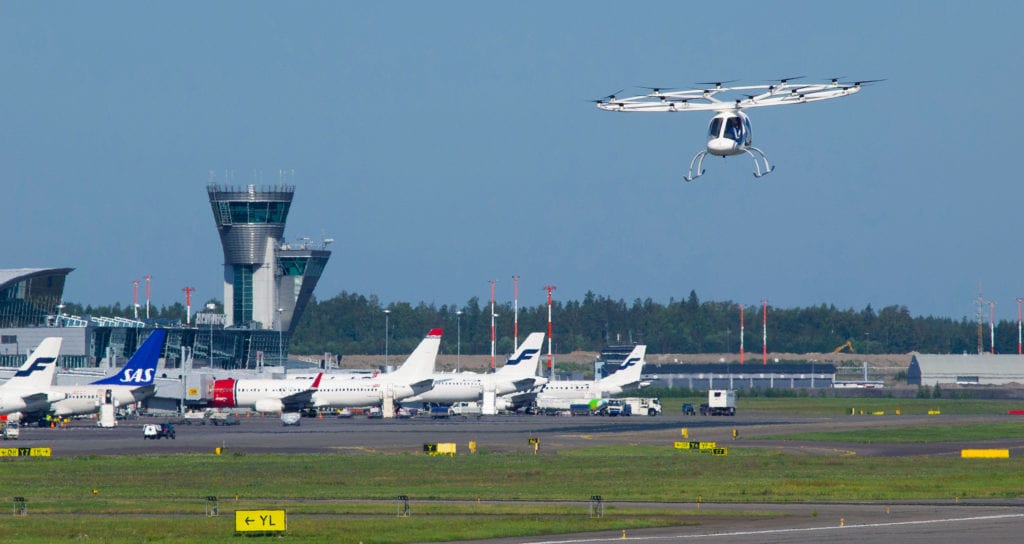
Volocopter 2x integrated into the airspace at Helsinki international airport. Photo: Volocopter
During a flight test at Helsinki International Airport on August 30, Volocopter and the Single European Sky ATM Research (SESAR) Gulf of Finland U-space team evaluated the ability of integrated air traffic management (ATM) and unmanned traffic management (UTM) systems to provide surveillance of future air taxi flights.
The demonstration was the final SESAR JU GOF U-space demonstration, a government-industry project designed to provide real live testing of technology that can provide future commercial drone traffic management throughout European airspace. Using a Volocopter air taxi equipped with a position reporting sensor, there were a series of flight tests performed using UTM systems provided by AirMap, Altitude Angel and Unifly.
Each test was designed to value the compatibility and usability of each company’s technology. The UTM platforms provided by AirMap, Altitude Angel and Unifly provide a real-time operating picture of the airspace for both manned and unmanned aircraft. AirMap for example, has been participating in drone traffic management-focused flight testing throughout the year in other areas of Europe as well, with the Volocopter demonstration being its first air taxi-focused test.
“We are happy to say that all providers we tested were compatible with the Volocopter systems,” Jan-Hendrik Boelens, chief technology officer at Volocopter, said of the Helsinki flight test.
Boelens said Volocopter sees the U-space project, which initially was singularly focused on drone traffic management, as able to provide the type of air traffic infrastructure and technological evaluation necessary to make future urban air mobility operations a reality.
“We will build our first VoloPort infrastructure before the year is out, and with the GOF U-Space demonstration we have now shown that the existing UTM technologies are viable for UAM. The indispensable aspects of the ecosystem exist, now it’s time to bring Urban Air Mobility to life,” Boelens said.
The flight test used a prototype version of VoloCity, the new production version air taxi design recently unveiled by Volocopter for the first time. In addition to the connection the air taxi had with the systems provided by the UTM service providers, it was also plugged in to all of the airport’s traditional air traffic control systems.

Volocopter 2x flying at Helsinki international airport. Photo: Volocopter
Data collected from the flight tests will be evaluated by SESAR’s U-space team to understand how air taxis, drones and manned aircraft can be integrated into the same airspace. The U-space team plans to present the results of the Volocopter and other drone management test flights in October.
Maria Tamm, project coordinator for Estonian Air Navigation Services (EANS), said the flight test shows the planned technologies and rules used to govern unmanned aircraft and air taxi flights in low-level airspace will need some updating.
 | Want more eVTOL and air taxi news? Sign up for our brand new e-letter, “The Skyport,” where every other week you’ll find the most important analysis and insider scoops from the urban air mobility world. |
“The demonstration at Helsinki airport showed that various systems are ready to safely and efficiently manage air taxi operations, their related services and subsequent interaction within existing aviation and airspace activities,” Tamm said.
Volocopter plans to fly its aircraft again publicly in Stuttgart, Germany on September 14, followed by a public revealing of its first Voloport structure in Singapore later in the year.